CDNF Exerts Anxiolytic, Antidepressant-like, and Procognitive Effects and Modulates Serotonin Turnover and Neuroplasticity-Related Genes
Abstract
:1. Introduction
2. Results
2.1. CDNF Injection Transiently Affects Body Weight and Sleep in Mice without Influencing Locomotor Activity or Feed and Water Consumption
2.2. CDNF Injection Improves Learning Abilities
2.3. CDNF Injection Produces Marked Anxiolytic-like and Antidepressant-Like Effects
2.4. CDNF Injection Results in Enhanced Serotonin Turnover
2.5. Expression of Genes Involved in the Reception, Reuptake, and Catabolism of 5-HT Is Affected by CDNF Injection
2.6. CDNF Injection Affects the Expression and Phosphorylation of c-Fos and CREB
2.7. The Expression of Key Genes Regulating ER Stress Is Affected by Injection of the CDNF Protein
3. Discussion
4. Materials and Methods
4.1. Animals
4.2. CDNF i.c.v. Injection
4.3. Tests under Home Cage Conditions
4.4. Assessment of Exploratory Activity, Anxiety, and Behavioral Despair
4.5. Excision of Brain Structures
4.6. Reverse Transcription
4.7. Quantitative Real-Time PCR
4.8. Western Blot
4.9. HPLC
4.10. Statistical Analysis
5. Conclusions
Author Contributions
Funding
Institutional Review Board Statement
Informed Consent Statement
Data Availability Statement
Acknowledgments
Conflicts of Interest
References
- Bondarenko, O.; Saarma, M. Neurotrophic Factors in Parkinson’s Disease: Clinical Trials, Open Challenges and Nanoparticle-Mediated Delivery to the Brain. Front. Cell. Neurosci. 2021, 15, 682597. [Google Scholar] [CrossRef] [PubMed]
- Zou, Y.; Zhang, Y.; Tu, M.; Ye, Y.; Li, M.; Ran, R.; Zou, Z. Brain-Derived Neurotrophic Factor Levels across Psychiatric Disorders: A Systemic Review and Network Meta-Analysis. Prog. Neuropsychopharmacol. Biol. Psychiatry 2024, 131, 110954. [Google Scholar] [CrossRef] [PubMed]
- Nikolac Perkovic, M.; Gredicak, M.; Sagud, M.; Nedic Erjavec, G.; Uzun, S.; Pivac, N. The Association of Brain-Derived Neurotrophic Factor with the Diagnosis and Treatment Response in Depression. Expert Rev. Mol. Diagn. 2023, 23, 283–296. [Google Scholar] [CrossRef] [PubMed]
- Castrén, E.; Monteggia, L.M. Brain-Derived Neurotrophic Factor Signaling in Depression and Antidepressant Action. Biol. Psychiatry 2021, 90, 128–136. [Google Scholar] [CrossRef] [PubMed]
- Casarotto, P.C.; Girych, M.; Fred, S.M.; Kovaleva, V.; Moliner, R.; Enkavi, G.; Biojone, C.; Cannarozzo, C.; Sahu, M.P.; Kaurinkoski, K.; et al. Antidepressant Drugs Act by Directly Binding to TRKB Neurotrophin Receptors. Cell 2021, 184, 1299–1313.e19. [Google Scholar] [CrossRef] [PubMed]
- Moliner, R.; Girych, M.; Brunello, C.A.; Kovaleva, V.; Biojone, C.; Enkavi, G.; Antenucci, L.; Kot, E.F.; Goncharuk, S.A.; Kaurinkoski, K.; et al. Psychedelics Promote Plasticity by Directly Binding to BDNF Receptor TrkB. Nat. Neurosci. 2023, 26, 1032–1041. [Google Scholar] [CrossRef]
- Shirayama, Y.; Chen, A.C.-H.; Nakagawa, S.; Russell, D.S.; Duman, R.S. Brain-Derived Neurotrophic Factor Produces Antidepressant Effects in Behavioral Models of Depression. J. Neurosci. Off. J. Soc. Neurosci. 2002, 22, 3251–3261. [Google Scholar] [CrossRef]
- Deltheil, T.; Guiard, B.P.; Cerdan, J.; David, D.J.; Tanaka, K.F.; Repérant, C.; Guilloux, J.-P.; Coudoré, F.; Hen, R.; Gardier, A.M. Behavioral and Serotonergic Consequences of Decreasing or Increasing Hippocampus Brain-Derived Neurotrophic Factor Protein Levels in Mice. Neuropharmacology 2008, 55, 1006–1014. [Google Scholar] [CrossRef]
- Tikhonova, M.A.; Kulikov, A.V.; Bazovkina, D.V.; Morozova, M.V.; Naumenko, V.S.; Popova, N.K. Antidepressant-like Effects of Central BDNF Administration in Mice of Antidepressant Sensitive Catalepsy (ASC) Strain. Chin. J. Physiol. 2012, 55, 284–293. [Google Scholar] [CrossRef]
- Naumenko, V.S.; Kondaurova, E.M.; Bazovkina, D.V.; Tsybko, A.S.; Tikhonova, M.A.; Kulikov, A.V.; Popova, N.K. Effect of Brain-Derived Neurotrophic Factor on Behavior and Key Members of the Brain Serotonin System in Genetically Predisposed to Behavioral Disorders Mouse Strains. Neuroscience 2012, 214, 59–67. [Google Scholar] [CrossRef]
- Tsybko, A.S.; Ilchibaeva, T.V.; Popova, N.K. Role of Glial Cell Line-Derived Neurotrophic Factor in the Pathogenesis and Treatment of Mood Disorders. Rev. Neurosci. 2017, 28, 219–233. [Google Scholar] [CrossRef] [PubMed]
- Wang, H.; Yang, Y.; Pei, G.; Wang, Z.; Chen, N. Neurotrophic Basis to the Pathogenesis of Depression and Phytotherapy. Front. Pharmacol. 2023, 14, 1182666. [Google Scholar] [CrossRef] [PubMed]
- Lindahl, M.; Saarma, M.; Lindholm, P. Unconventional Neurotrophic Factors CDNF and MANF: Structure, Physiological Functions and Therapeutic Potential. Neurobiol. Dis. 2017, 97, 90–102. [Google Scholar] [CrossRef]
- Lõhelaid, H.; Saarma, M.; Airavaara, M. CDNF and ER Stress: Pharmacology and Therapeutic Possibilities. Pharmacol. Ther. 2024, 254, 108594. [Google Scholar] [CrossRef]
- Eesmaa, A.; Yu, L.-Y.; Göös, H.; Danilova, T.; Nõges, K.; Pakarinen, E.; Varjosalo, M.; Lindahl, M.; Lindholm, P.; Saarma, M. CDNF Interacts with ER Chaperones and Requires UPR Sensors to Promote Neuronal Survival. Int. J. Mol. Sci. 2022, 23, 9489. [Google Scholar] [CrossRef] [PubMed]
- De Lorenzo, F.; Lüningschrör, P.; Nam, J.; Beckett, L.; Pilotto, F.; Galli, E.; Lindholm, P.; Rüdt von Collenberg, C.; Mungwa, S.T.; Jablonka, S.; et al. CDNF Rescues Motor Neurons in Models of Amyotrophic Lateral Sclerosis by Targeting Endoplasmic Reticulum Stress. Brain 2023, 146, 3783–3799. [Google Scholar] [CrossRef]
- Pakarinen, E.; Lindholm, P.; Saarma, M.; Lindahl, M. CDNF and MANF Regulate ER Stress in a Tissue-Specific Manner. Cell. Mol. Life Sci. 2022, 79, 124. [Google Scholar] [CrossRef]
- Parkash, V.; Lindholm, P.; Peränen, J.; Kalkkinen, N.; Oksanen, E.; Saarma, M.; Leppänen, V.M.; Goldman, A. The Structure of the Conserved Neurotrophic Factors MANF and CDNF Explains Why They Are Bifunctional. Protein Eng. Des. Sel. 2009, 22, 233–241. [Google Scholar] [CrossRef]
- Maciel, L.; de Oliveira, D.F.; Mesquita, F.; Souza, H.A.d.S.; Oliveira, L.; Christie, M.L.A.; Palhano, F.L.; Campos de Carvalho, A.C.; Nascimento, J.H.M.; Foguel, D. New Cardiomyokine Reduces Myocardial Ischemia/Reperfusion Injury by PI3K-AKT Pathway Via a Putative KDEL-Receptor Binding. J. Am. Heart Assoc. 2021, 10, e019685. [Google Scholar] [CrossRef]
- Cheng, L.; Zhao, H.; Zhang, W.; Liu, B.; Liu, Y.; Guo, Y.; Nie, L. Overexpression of Conserved Dopamine Neurotrophic Factor (CDNF) in Astrocytes Alleviates Endoplasmic Reticulum Stress-Induced Cell Damage and Inflammatory Cytokine Secretion. Biochem. Biophys. Res. Commun. 2013, 435, 34–39. [Google Scholar] [CrossRef]
- Zhao, H.; Cheng, L.; Liu, Y.; Zhang, W.; Maharjan, S.; Cui, Z.; Wang, X.; Tang, D.; Nie, L. Mechanisms of Anti-Inflammatory Property of Conserved Dopamine Neurotrophic Factor: Inhibition of JNK Signaling in Lipopolysaccharide-Induced Microglia. J. Mol. Neurosci. 2014, 52, 186–192. [Google Scholar] [CrossRef] [PubMed]
- Zhang, Y.; Xiang, Y.; Wang, X.; Zhu, L.; Li, H.; Wang, S.; Pan, X.; Zhao, H. Cerebral Dopamine Neurotrophic Factor Protects Microglia by Combining with AKT and by Regulating FoxO1/MTOR Signaling during Neuroinflammation. Biomed. Pharmacother. 2019, 109, 2278–2284. [Google Scholar] [CrossRef] [PubMed]
- Nadella, R.; Voutilainen, M.H.; Saarma, M.; Gonzalez-Barrios, J.A.; Leon-Chavez, B.A.; Jiménez, J.M.D.; Jiménez, S.H.D.; Escobedo, L.; Martinez-Fong, D. Transient Transfection of Human CDNF Gene Reduces the 6-Hydroxydopamine-Induced Neuroinflammation in the Rat Substantia Nigra. J. Neuroinflamm. 2014, 11, 209. [Google Scholar] [CrossRef] [PubMed]
- Tseng, K.-Y.; Stratoulias, V.; Hu, W.-F.; Wu, J.-S.; Wang, V.; Chen, Y.-H.; Seelbach, A.; Huttunen, H.J.; Kulesskaya, N.; Pang, C.-Y.; et al. Augmenting Hematoma-Scavenging Capacity of Innate Immune Cells by CDNF Reduces Brain Injury and Promotes Functional Recovery after Intracerebral Hemorrhage. Cell Death Dis. 2023, 14, 128. [Google Scholar] [CrossRef]
- Albert, K.; Raymundo, D.P.; Panhelainen, A.; Eesmaa, A.; Shvachiy, L.; Araújo, G.R.; Chmielarz, P.; Yan, X.; Singh, A.; Cordeiro, Y.; et al. Cerebral Dopamine Neurotrophic Factor Reduces α-Synuclein Aggregation and Propagation and Alleviates Behavioral Alterations in Vivo. Mol. Ther. 2021, 29, 2821–2840. [Google Scholar] [CrossRef]
- Lindholm, P.; Voutilainen, M.H.; Laurén, J.; Peränen, J.; Leppänen, V.-M.; Andressoo, J.-O.; Lindahl, M.; Janhunen, S.; Kalkkinen, N.; Timmusk, T.; et al. Novel Neurotrophic Factor CDNF Protects and Rescues Midbrain Dopamine Neurons in Vivo. Nature 2007, 448, 73–77. [Google Scholar] [CrossRef]
- Voutilainen, M.H.; Bäck, S.; Peränen, J.; Lindholm, P.; Raasmaja, A.; Männistö, P.T.; Saarma, M.; Tuominen, R.K. Chronic Infusion of CDNF Prevents 6-OHDA-Induced Deficits in a Rat Model of Parkinson’s Disease. Exp. Neurol. 2011, 228, 99–108. [Google Scholar] [CrossRef]
- Voutilainen, M.H.; De Lorenzo, F.; Stepanova, P.; Bäck, S.; Yu, L.-Y.; Lindholm, P.; Pörsti, E.; Saarma, M.; Männistö, P.T.; Tuominen, R.K. Evidence for an Additive Neurorestorative Effect of Simultaneously Administered CDNF and GDNF in Hemiparkinsonian Rats: Implications for Different Mechanism of Action. eNeuro 2017, 4, ENEURO.0117-16.2017. [Google Scholar] [CrossRef]
- Airavaara, M.; Harvey, B.K.; Voutilainen, M.H.; Shen, H.; Chou, J.; Lindholm, P.; Lindahl, M.; Tuominen, R.K.; Saarma, M.; Hoffer, B.; et al. CDNF Protects the Nigrostriatal Dopamine System and Promotes Recovery after MPTP Treatment in Mice. Cell Transplant. 2012, 21, 1213–1223. [Google Scholar] [CrossRef]
- Bäck, S.; Peränen, J.; Galli, E.; Pulkkila, P.; Lonka-Nevalaita, L.; Tamminen, T.; Voutilainen, M.H.; Raasmaja, A.; Saarma, M.; Männistö, P.T.; et al. Gene Therapy with AAV2-CDNF Provides Functional Benefits in a Rat Model of Parkinson’s Disease. Brain Behav. 2013, 3, 75–88. [Google Scholar] [CrossRef]
- Ren, X.; Zhang, T.; Gong, X.; Hu, G.; Ding, W.; Wang, X. AAV2-Mediated Striatum Delivery of Human CDNF Prevents the Deterioration of Midbrain Dopamine Neurons in a 6-Hydroxydopamine Induced Parkinsonian Rat Model. Exp. Neurol. 2013, 248, 148–156. [Google Scholar] [CrossRef] [PubMed]
- Garea-Rodríguez, E.; Eesmaa, A.; Lindholm, P.; Schlumbohm, C.; König, J.; Meller, B.; Krieglstein, K.; Helms, G.; Saarma, M.; Fuchs, E. Comparative Analysis of the Effects of Neurotrophic Factors CDNF and GDNF in a Nonhuman Primate Model of Parkinson’s Disease. PLoS ONE 2016, 11, e0149776. [Google Scholar] [CrossRef] [PubMed]
- Cordero-Llana, Ó.; Houghton, B.C.; Rinaldi, F.; Taylor, H.; Yáñez-Muñoz, R.J.; Uney, J.B.; Wong, L.-F.; Caldwell, M.A. Enhanced Efficacy of the CDNF/MANF Family by Combined Intranigral Overexpression in the 6-OHDA Rat Model of Parkinson’s Disease. Mol. Ther. 2015, 23, 244–254. [Google Scholar] [CrossRef] [PubMed]
- Huotarinen, A.; Penttinen, A.-M.; Bäck, S.; Voutilainen, M.H.; Julku, U.; Piepponen, T.P.; Männistö, P.T.; Saarma, M.; Tuominen, R.; Laakso, A.; et al. Combination of CDNF and Deep Brain Stimulation Decreases Neurological Deficits in Late-Stage Model Parkinson’s Disease. Neuroscience 2018, 374, 250–263. [Google Scholar] [CrossRef] [PubMed]
- Stepanova, P.; Srinivasan, V.; Lindholm, D.; Voutilainen, M.H. Cerebral Dopamine Neurotrophic Factor (CDNF) Protects against Quinolinic Acid-Induced Toxicity in in Vitro and in Vivo Models of Huntington’s Disease. Sci. Rep. 2020, 10, 19045. [Google Scholar] [CrossRef]
- Zhao, H.; Cheng, L.; Du, X.; Hou, Y.; Liu, Y.; Cui, Z.; Nie, L. Transplantation of Cerebral Dopamine Neurotrophic Factor Transducted BMSCs in Contusion Spinal Cord Injury of Rats: Promotion of Nerve Regeneration by Alleviating Neuroinflammation. Mol. Neurobiol. 2016, 53, 187–199. [Google Scholar] [CrossRef]
- Zhang, G.-L.; Wang, L.-H.; Liu, X.-Y.; Zhang, Y.-X.; Hu, M.-Y.; Liu, L.; Fang, Y.-Y.; Mu, Y.; Zhao, Y.; Huang, S.-H.; et al. Cerebral Dopamine Neurotrophic Factor (CDNF) Has Neuroprotective Effects against Cerebral Ischemia That May Occur through the Endoplasmic Reticulum Stress Pathway. Int. J. Mol. Sci. 2018, 19, 1905. [Google Scholar] [CrossRef]
- Huttunen, H.J.; Booms, S.; Sjögren, M.; Kerstens, V.; Johansson, J.; Holmnäs, R.; Koskinen, J.; Kulesskaya, N.; Fazio, P.; Woolley, M.; et al. Intraputamenal Cerebral Dopamine Neurotrophic Factor in Parkinson’s Disease: A Randomized, Double-Blind, Multicenter Phase 1 Trial. Mov. Disord. 2023, 38, 1209–1222. [Google Scholar] [CrossRef]
- Chalazonitis, A.; Li, Z.; Pham, T.D.; Chen, J.; Rao, M.; Lindholm, P.; Saarma, M.; Lindahl, M.; Gershon, M.D. Cerebral Dopamine Neurotrophic Factor Is Essential for Enteric Neuronal Development, Maintenance, and Regulation of Gastrointestinal Transit. J. Comp. Neurol. 2020, 528, 2420–2444. [Google Scholar] [CrossRef]
- Chen, Y.-C.C.; Baronio, D.; Semenova, S.; Abdurakhmanova, S.; Panula, P. Cerebral Dopamine Neurotrophic Factor Regulates Multiple Neuronal Subtypes and Behavior. J. Neurosci. 2020, 40, 6146–6164. [Google Scholar] [CrossRef]
- Kemppainen, S.; Lindholm, P.; Galli, E.; Lahtinen, H.-M.M.; Koivisto, H.; Hämäläinen, E.; Saarma, M.; Tanila, H. Cerebral Dopamine Neurotrophic Factor Improves Long-Term Memory in APP/PS1 Transgenic Mice Modeling Alzheimer’s Disease as Well as in Wild-Type Mice. Behav. Brain Res. 2015, 291, 1–11. [Google Scholar] [CrossRef] [PubMed]
- Kaminskaya, Y.P.; Ilchibaeva, T.V.; Khotskin, N.V.; Naumenko, V.S.; Tsybko, A.S. Effect of Hippocampal Overexpression of Dopamine Neurotrophic Factor (CDNF) on Behavior of Mice with Genetic Predisposition to Depressive-Like Behavior. Biochemistry 2023, 88, 1070–1091. [Google Scholar] [CrossRef] [PubMed]
- Eckel-Mahan, K.; Sassone-Corsi, P. Phenotyping Circadian Rhythms in Mice. Curr. Protoc. Mouse Biol. 2015, 5, 271–281. [Google Scholar] [CrossRef] [PubMed]
- Minatohara, K.; Akiyoshi, M.; Okuno, H. Role of Immediate-Early Genes in Synaptic Plasticity and Neuronal Ensembles Underlying the Memory Trace. Front. Mol. Neurosci. 2015, 8, 78. [Google Scholar] [CrossRef] [PubMed]
- Balcerek, E.; Włodkowska, U.; Czajkowski, R. Retrosplenial Cortex in Spatial Memory: Focus on Immediate Early Genes Mapping. Mol. Brain 2021, 14, 172. [Google Scholar] [CrossRef]
- Belgacem, Y.H.; Borodinsky, L.N. CREB at the Crossroads of Activity-Dependent Regulation of Nervous System Development and Function. Adv. Exp. Med. Biol. 2017, 1015, 19–39. [Google Scholar] [CrossRef]
- Kaldun, J.C.; Sprecher, S.G. Initiated by CREB: Resolving Gene Regulatory Programs in Learning and Memory: Switch in Cofactors and Transcription Regulators between Memory Consolidation and Maintenance Network. Bioessays 2019, 41, e1900045. [Google Scholar] [CrossRef]
- Sharma, V.K.; Singh, T.G. CREB: A Multifaceted Target for Alzheimer’s Disease. Curr. Alzheimer Res. 2020, 17, 1280–1293. [Google Scholar] [CrossRef]
- Ip, N.Y.; Li, Y.; Yancopoulos, G.D.; Lindsay, R.M. Cultured Hippocampal Neurons Show Responses to BDNF, NT-3, and NT-4, but Not NGF. J. Neurosci. Off. J. Soc. Neurosci. 1993, 13, 3394–3405. [Google Scholar] [CrossRef]
- Marsh, H.N.; Scholz, W.K.; Lamballe, F.; Klein, R.; Nanduri, V.; Barbacid, M.; Palfrey, H.C. Signal Transduction Events Mediated by the BDNF Receptor Gp 145trkB in Primary Hippocampal Pyramidal Cell Culture. J. Neurosci. Off. J. Soc. Neurosci. 1993, 13, 4281–4292. [Google Scholar] [CrossRef]
- Lindholm, D.; Dechant, G.; Heisenberg, C.P.; Thoenen, H. Brain-Derived Neurotrophic Factor Is a Survival Factor for Cultured Rat Cerebellar Granule Neurons and Protects Them against Glutamate-Induced Neurotoxicity. Eur. J. Neurosci. 1993, 5, 1455–1464. [Google Scholar] [CrossRef] [PubMed]
- Roback, J.D.; Marsh, H.N.; Downen, M.; Palfrey, H.C.; Wainer, B.H. BDNF-Activated Signal Transduction in Rat Cortical Glial Cells. Eur. J. Neurosci. 1995, 7, 849–862. [Google Scholar] [CrossRef] [PubMed]
- Alder, J.; Thakker-Varia, S.; Bangasser, D.A.; Kuroiwa, M.; Plummer, M.R.; Shors, T.J.; Black, I.B. Brain-Derived Neurotrophic Factor-Induced Gene Expression Reveals Novel Actions of VGF in Hippocampal Synaptic Plasticity. J. Neurosci. Off. J. Soc. Neurosci. 2003, 23, 10800–10808. [Google Scholar] [CrossRef] [PubMed]
- El-Sayed, M.; Hofman-Bang, J.; Mikkelsen, J.D. Effect of Brain-Derived Neurotrophic Factor on Activity-Regulated Cytoskeleton-Associated Protein Gene Expression in Primary Frontal Cortical Neurons. Comparison with NMDA and AMPA. Eur. J. Pharmacol. 2011, 660, 351–357. [Google Scholar] [CrossRef] [PubMed]
- Hsieh, T.F.; Simler, S.; Vergnes, M.; Gass, P.; Marescaux, C.; Wiegand, S.J.; Zimmermann, M.; Herdegen, T. BDNF Restores the Expression of Jun and Fos Inducible Transcription Factors in the Rat Brain Following Repetitive Electroconvulsive Seizures. Exp. Neurol. 1998, 149, 161–174. [Google Scholar] [CrossRef]
- Jongen, J.L.M.; Haasdijk, E.D.; Sabel-Goedknegt, H.; van der Burg, J.; Vecht, C.J.; Holstege, J.C. Intrathecal Injection of GDNF and BDNF Induces Immediate Early Gene Expression in Rat Spinal Dorsal Horn. Exp. Neurol. 2005, 194, 255–266. [Google Scholar] [CrossRef]
- Engele, J.; Schilling, K. Growth Factor-Induced c-Fos Expression Defines Distinct Subsets of Midbrain Dopaminergic Neurons. Neuroscience 1996, 73, 397–406. [Google Scholar] [CrossRef]
- Engele, J.; Franke, B. Effects of Glial Cell Line-Derived Neurotrophic Factor (GDNF) on Dopaminergic Neurons Require Concurrent Activation of CAMP-Dependent Signaling Pathways. Cell Tissue Res. 1996, 286, 235–240. [Google Scholar] [CrossRef]
- Hishiki, T.; Nimura, Y.; Isogai, E.; Kondo, K.; Ichimiya, S.; Nakamura, Y.; Ozaki, T.; Sakiyama, S.; Hirose, M.; Seki, N.; et al. Glial Cell Line-Derived Neurotrophic Factor/Neurturin-Induced Differentiation and Its Enhancement by Retinoic Acid in Primary Human Neuroblastomas Expressing c-Ret, GFR Alpha-1, and GFR Alpha-2. Cancer Res. 1998, 58, 2158–2165. [Google Scholar]
- Trupp, M.; Scott, R.; Whittemore, S.R.; Ibáñez, C.F. Ret-Dependent and -Independent Mechanisms of Glial Cell Line-Derived Neurotrophic Factor Signaling in Neuronal Cells. J. Biol. Chem. 1999, 274, 20885–20894. [Google Scholar] [CrossRef]
- Schatz, D.S.; Kaufmann, W.A.; Saria, A.; Humpel, C. Dopamine Neurons in a Simple GDNF-Treated Meso-Striatal Organotypic Co-Culture Model. Exp. Brain Res. 1999, 127, 270–278. [Google Scholar] [CrossRef] [PubMed]
- Pezeshki, G.; Franke, B.; Engele, J. GDNF Elicits Distinct Immediate-Early Gene Responses in Cultured Cortical and Mesencephalic Neurons. J. Neurosci. Res. 2003, 71, 478–484. [Google Scholar] [CrossRef]
- Finkbeiner, S.; Tavazoie, S.F.; Maloratsky, A.; Jacobs, K.M.; Harris, K.M.; Greenberg, M.E. CREB: A Major Mediator of Neuronal Neurotrophin Responses. Neuron 1997, 19, 1031–1047. [Google Scholar] [CrossRef] [PubMed]
- Pizzorusso, T.; Ratto, G.M.; Putignano, E.; Maffei, L. Brain-Derived Neurotrophic Factor Causes CAMP Response Element-Binding Protein Phosphorylation in Absence of Calcium Increases in Slices and Cultured Neurons from Rat Visual Cortex. J. Neurosci. Off. J. Soc. Neurosci. 2000, 20, 2809–2816. [Google Scholar] [CrossRef] [PubMed]
- Blanquet, P.R.; Mariani, J.; Derer, P. A Calcium/Calmodulin Kinase Pathway Connects Brain-Derived Neurotrophic Factor to the Cyclic AMP-Responsive Transcription Factor in the Rat Hippocampus. Neuroscience 2003, 118, 477–490. [Google Scholar] [CrossRef]
- Esvald, E.-E.; Tuvikene, J.; Sirp, A.; Patil, S.; Bramham, C.R.; Timmusk, T. CREB Family Transcription Factors Are Major Mediators of BDNF Transcriptional Autoregulation in Cortical Neurons. J. Neurosci. Off. J. Soc. Neurosci. 2020, 40, 1405–1426. [Google Scholar] [CrossRef]
- Martin, D.; Miller, G.; Fischer, N.; Diz, D.; Cullen, T.; Russell, D. Glial Cell Line-Derived Neurotrophic Factor: The Lateral Cerebral Ventricle as a Site of Administration for Stimulation of the Substantia Nigra Dopamine System in Rats. Eur. J. Neurosci. 1996, 8, 1249–1255. [Google Scholar] [CrossRef]
- Toriya, M.; Maekawa, F.; Maejima, Y.; Onaka, T.; Fujiwara, K.; Nakagawa, T.; Nakata, M.; Yada, T. Long-Term Infusion of Brain-Derived Neurotrophic Factor Reduces Food Intake and Body Weight via a Corticotrophin-Releasing Hormone Pathway in the Paraventricular Nucleus of the Hypothalamus. J. Neuroendocrinol. 2010, 22, 987–995. [Google Scholar] [CrossRef]
- Naert, G.; Ixart, G.; Tapia-Arancibia, L.; Givalois, L. Continuous i.c.v. Infusion of Brain-Derived Neurotrophic Factor Modifies Hypothalamic-Pituitary-Adrenal Axis Activity, Locomotor Activity and Body Temperature Rhythms in Adult Male Rats. Neuroscience 2006, 139, 779–789. [Google Scholar] [CrossRef]
- Kushikata, T.; Fang, J.; Krueger, J.M. Brain-Derived Neurotrophic Factor Enhances Spontaneous Sleep in Rats and Rabbits. Am. J. Physiol. 1999, 276, R1334–R1338. [Google Scholar] [CrossRef]
- Faraguna, U.; Vyazovskiy, V.V.; Nelson, A.B.; Tononi, G.; Cirelli, C. A Causal Role for Brain-Derived Neurotrophic Factor in the Homeostatic Regulation of Sleep. J. Neurosci. Off. J. Soc. Neurosci. 2008, 28, 4088–4095. [Google Scholar] [CrossRef] [PubMed]
- Kushikata, T.; Kubota, T.; Fang, J.; Krueger, J.M. Glial Cell Line-Derived Neurotrophic Factor Promotes Sleep in Rats and Rabbits. Am. J. Physiol. Regul. Integr. Comp. Physiol. 2001, 280, R1001–R1006. [Google Scholar] [CrossRef]
- Subramanian, K. Restoration of Motor and Non-Motor Functions by Neurotrophic Factors in Nonhuman Primates with Dopamine Depletion. Ph.D. Thesis, University of Pittsburgh, Pittsburgh, PA, USA, 2013. [Google Scholar]
- Gruart, A.; Leal-Campanario, R.; López-Ramos, J.C.; Delgado-García, J.M. Functional Basis of Associative Learning and Its Relationships with Long-Term Potentiation Evoked in the Involved Neural Circuits: Lessons from Studies in Behaving Mammals. Neurobiol. Learn. Mem. 2015, 124, 3–18. [Google Scholar] [CrossRef]
- Siuciak, J.A.; Boylan, C.; Fritsche, M.; Altar, C.A.; Lindsay, R.M. BDNF Increases Monoaminergic Activity in Rat Brain Following Intracerebroventricular or Intraparenchymal Administration. Brain Res. 1996, 710, 11–20. [Google Scholar] [CrossRef]
- Naumenko, V.S.; Kondaurova, E.M.; Bazovkina, D.V.; Tsybko, A.S.; Il’chibaeva, T.V.; Popova, N.K. On the Role of 5-HT1A receptor Gene in Behavioral Effect of Brain-Derived Neurotrophic Factor. J. Neurosci. Res. 2014, 92, 1035–1043. [Google Scholar] [CrossRef]
- Bazovkina, D.; Naumenko, V.; Bazhenova, E.; Kondaurova, E. Effect of Central Administration of Brain-Derived Neurotrophic Factor (BDNF) on Behavior and Brain Monoamine Metabolism in New Recombinant Mouse Lines Differing by 5-HT(1A) Receptor Functionality. Int. J. Mol. Sci. 2021, 22, 11987. [Google Scholar] [CrossRef]
- Puig, M.V.; Gulledge, A.T. Serotonin and Prefrontal Cortex Function: Neurons, Networks, and Circuits. Mol. Neurobiol. 2011, 44, 449–464. [Google Scholar] [CrossRef]
- Sharp, T.; Boothman, L.; Raley, J.; Quérée, P. Important Messages in the “Post”: Recent Discoveries in 5-HT Neurone Feedback Control. Trends Pharmacol. Sci. 2007, 28, 629–636. [Google Scholar] [CrossRef]
- Ogren, S.O.; Eriksson, T.M.; Elvander-Tottie, E.; D’Addario, C.; Ekström, J.C.; Svenningsson, P.; Meister, B.; Kehr, J.; Stiedl, O. The Role of 5-HT(1A) Receptors in Learning and Memory. Behav. Brain Res. 2008, 195, 54–77. [Google Scholar] [CrossRef]
- Tian, M.K.; Schmidt, E.F.; Lambe, E.K. Serotonergic Suppression of Mouse Prefrontal Circuits Implicated in Task Attention. eNeuro 2016, 3, ENEURO.0269-16.2016. [Google Scholar] [CrossRef]
- Renner, U.; Zeug, A.; Woehler, A.; Niebert, M.; Dityatev, A.; Dityateva, G.; Gorinski, N.; Guseva, D.; Abdel-Galil, D.; Fröhlich, M.; et al. Heterodimerization of Serotonin Receptors 5-HT1A and 5-HT7 Differentially Regulates Receptor Signalling and Trafficking. J. Cell Sci. 2012, 125, 2486–2499. [Google Scholar] [CrossRef] [PubMed]
- Keck, B.J.; Lakoski, J.M. Region-Specific Serotonin1A Receptor Turnover Following Irreversible Blockade with EEDQ. Neuroreport 1996, 7, 2717–2721. [Google Scholar] [CrossRef] [PubMed]
- Vicentic, A.; Cabrera-Vera, T.M.; Pinto, W.; Battaglia, G. 5-HT(1A) and 5-HT(2A) Serotonin Receptor Turnover in Adult Rat Offspring Prenatally Exposed to Cocaine. Brain Res. 2000, 877, 141–148. [Google Scholar] [CrossRef] [PubMed]
- Kumar, G.A.; Sarkar, P.; Jafurulla, M.; Singh, S.P.; Srinivas, G.; Pande, G.; Chattopadhyay, A. Exploring Endocytosis and Intracellular Trafficking of the Human Serotonin(1A) Receptor. Biochemistry 2019, 58, 2628–2641. [Google Scholar] [CrossRef]
- Van Krieken, R.; Tsai, Y.-L.; Carlos, A.J.; Ha, D.P.; Lee, A.S. ER Residential Chaperone GRP78 Unconventionally Relocalizes to the Cell Surface via Endosomal Transport. Cell. Mol. Life Sci. 2021, 78, 5179–5195. [Google Scholar] [CrossRef]
- Fernandez, S.P.; Muzerelle, A.; Scotto-Lomassese, S.; Barik, J.; Gruart, A.; Delgado-García, J.M.; Gaspar, P. Constitutive and Acquired Serotonin Deficiency Alters Memory and Hippocampal Synaptic Plasticity. Neuropsychopharmacol. Off. Publ. Am. Coll. Neuropsychopharmacol. 2017, 42, 512–523. [Google Scholar] [CrossRef]
- Naoi, M.; Maruyama, W.; Shamoto-Nagai, M. Type A Monoamine Oxidase and Serotonin Are Coordinately Involved in Depressive Disorders: From Neurotransmitter Imbalance to Impaired Neurogenesis. J. Neural Transm. 2018, 125, 53–66. [Google Scholar] [CrossRef]
- Godar, S.C.; Bortolato, M.; Richards, S.E.; Li, F.G.; Chen, K.; Wellman, C.L.; Shih, J.C. Monoamine Oxidase A Is Required for Rapid Dendritic Remodeling in Response to Stress. Int. J. Neuropsychopharmacol. 2015, 18, pyv035. [Google Scholar] [CrossRef]
- Naumenko, V.S.; Kondaurova, E.M.; Bazovkina, D.V.; Tsybko, A.S.; Ilchibaeva, T.V.; Khotskin, N.V.; Semenova, A.A.; Popova, N.K. Effect of GDNF on Depressive-like Behavior, Spatial Learning and Key Genes of the Brain Dopamine System in Genetically Predisposed to Behavioral Disorders Mouse Strains. Behav. Brain Res. 2014, 274, 1–9. [Google Scholar] [CrossRef]
- Beck, C.H. Acute Treatment with Antidepressant Drugs Selectively Increases the Expression of C-Fos in the Rat Brain. J. Psychiatry Neurosci. 1995, 20, 25–32. [Google Scholar]
- Horowitz, J.M.; Hallas, B.H.; Torres, G. Rat Strain Differences to Fluoxetine in Striatal Fos-like Proteins. Neuroreport 2002, 13, 2463–2467. [Google Scholar] [CrossRef] [PubMed]
- Lino-de-Oliveira, C.; Sales, A.J.; Del Bel, E.A.; Silveira, M.C.; Guimarães, F.S. Effects of Acute and Chronic Fluoxetine Treatments on Restraint Stress-Induced Fos Expression. Brain Res. Bull. 2001, 55, 747–754. [Google Scholar] [CrossRef] [PubMed]
- Torres, G.; Horowitz, J.M.; Laflamme, N.; Rivest, S. Fluoxetine Induces the Transcription of Genes Encoding C-Fos, Corticotropin-Releasing Factor and Its Type 1 Receptor in Rat Brain. Neuroscience 1998, 87, 463–477. [Google Scholar] [CrossRef]
- Tiraboschi, E.; Tardito, D.; Kasahara, J.; Moraschi, S.; Pruneri, P.; Gennarelli, M.; Racagni, G.; Popoli, M. Selective Phosphorylation of Nuclear CREB by Fluoxetine Is Linked to Activation of CaM Kinase IV and MAP Kinase Cascades. Neuropsychopharmacol. Off. Publ. Am. Coll. Neuropsychopharmacol. 2004, 29, 1831–1840. [Google Scholar] [CrossRef] [PubMed]
- Qi, X.; Lin, W.; Li, J.; Li, H.; Wang, W.; Wang, D.; Sun, M. Fluoxetine Increases the Activity of the ERK-CREB Signal System and Alleviates the Depressive-like Behavior in Rats Exposed to Chronic Forced Swim Stress. Neurobiol. Dis. 2008, 31, 278–285. [Google Scholar] [CrossRef]
- Maćkowiak, M.; Chocyk, A.; Fijał, K.; Czyrak, A.; Wedzony, K. C-Fos Proteins, Induced by the Serotonin Receptor Agonist DOI, Are Not Expressed in 5-HT2A Positive Cortical Neurons. Brain Res. Mol. Brain Res. 1999, 71, 358–363. [Google Scholar] [CrossRef]
- Rioja, J.; Santín, L.J.; Doña, A.; de Pablos, L.; Minano, F.J.; Gonzalez-Baron, S.; Aguirre, J.A. 5-HT1A Receptor Activation Counteracts c-Fos Immunoreactivity Induced in Serotonin Neurons of the Raphe Nuclei after Immobilization Stress in the Male Rat. Neurosci. Lett. 2006, 397, 190–195. [Google Scholar] [CrossRef]
- Salchner, P.; Singewald, N. 5-HT Receptor Subtypes Involved in the Anxiogenic-like Action and Associated Fos Response of Acute Fluoxetine Treatment in Rats. Psychopharmacology 2006, 185, 282–288. [Google Scholar] [CrossRef]
- Kondaurova, E.M.; Plyusnina, A.V.; Ilchibaeva, T.V.; Eremin, D.V.; Rodnyy, A.Y.; Grygoreva, Y.D.; Naumenko, V.S. Effects of a Cc2d1a/Freud-1 Knockdown in the Hippocampus on Behavior, the Serotonin System, and BDNF. Int. J. Mol. Sci. 2021, 22, 13319. [Google Scholar] [CrossRef]
- Madhav, T.R.; Pei, Q.; Zetterström, T.S. Serotonergic Cells of the Rat Raphe Nuclei Express MRNA of Tyrosine Kinase B (TrkB), the High-Affinity Receptor for Brain Derived Neurotrophic Factor (BDNF). Brain Res. Mol. Brain Res. 2001, 93, 56–63. [Google Scholar] [CrossRef]
- Adachi, M.; Autry, A.E.; Mahgoub, M.; Suzuki, K.; Monteggia, L.M. TrkB Signaling in Dorsal Raphe Nucleus Is Essential for Antidepressant Efficacy and Normal Aggression Behavior. Neuropsychopharmacol. Off. Publ. Am. Coll. Neuropsychopharmacol. 2017, 42, 886–894. [Google Scholar] [CrossRef] [PubMed]
- Galter, D.; Unsicker, K. Brain-Derived Neurotrophic Factor and TrkB Are Essential for CAMP-Mediated Induction of the Serotonergic Neuronal Phenotype. J. Neurosci. Res. 2000, 61, 295–301. [Google Scholar] [CrossRef] [PubMed]
- Sahu, M.P.; Pazos-Boubeta, Y.; Steinzeig, A.; Kaurinkoski, K.; Palmisano, M.; Borowecki, O.; Piepponen, T.P.; Castrén, E. Depletion of TrkB Receptors from Adult Serotonergic Neurons Increases Brain Serotonin Levels, Enhances Energy Metabolism and Impairs Learning and Memory. Front. Mol. Neurosci. 2021, 14, 616178. [Google Scholar] [CrossRef] [PubMed]
- Groenendyk, J.; Michalak, M. Interplay between Calcium and Endoplasmic Reticulum Stress. Cell Calcium 2023, 113, 102753. [Google Scholar] [CrossRef] [PubMed]
- Martínez, G.; Vidal, R.L.; Mardones, P.; Serrano, F.G.; Ardiles, A.O.; Wirth, C.; Valdés, P.; Thielen, P.; Schneider, B.L.; Kerr, B.; et al. Regulation of Memory Formation by the Transcription Factor XBP1. Cell Rep. 2016, 14, 1382–1394. [Google Scholar] [CrossRef]
- Cissé, M.; Duplan, E.; Lorivel, T.; Dunys, J.; Bauer, C.; Meckler, X.; Gerakis, Y.; Lauritzen, I.; Checler, F. The Transcription Factor XBP1s Restores Hippocampal Synaptic Plasticity and Memory by Control of the Kalirin-7 Pathway in Alzheimer Model. Mol. Psychiatry 2017, 22, 1562–1575. [Google Scholar] [CrossRef]
- Kezuka, D.; Tkarada-Iemata, M.; Hattori, T.; Mori, K.; Takahashi, R.; Kitao, Y.; Hori, O. Deletion of Atf6α Enhances Kainate-Induced Neuronal Death in Mice. Neurochem. Int. 2016, 92, 67–74. [Google Scholar] [CrossRef]
- Wang, S.; Hu, B.; Ding, Z.; Dang, Y.; Wu, J.; Li, D.; Liu, X.; Xiao, B.; Zhang, W.; Ren, R.; et al. ATF6 Safeguards Organelle Homeostasis and Cellular Aging in Human Mesenchymal Stem Cells. Cell Discov. 2018, 4, 1–19. [Google Scholar] [CrossRef]
- Mätlik, K.; Vihinen, H.; Bienemann, A.; Palgi, J.; Voutilainen, M.H.; Booms, S.; Lindahl, M.; Jokitalo, E.; Saarma, M.; Huttunen, H.J.; et al. Intrastriatally Infused Exogenous CDNF Is Endocytosed and Retrogradely Transported to Substantia Nigra. eNeuro 2017, 4, e0128-16.2017. [Google Scholar] [CrossRef]
- Poduslo, J.F.; Curran, G.L. Permeability at the Blood-Brain and Blood-Nerve Barriers of the Neurotrophic Factors: NGF, CNTF, NT-3, BDNF. Brain Res. Mol. Brain Res. 1996, 36, 280–286. [Google Scholar] [CrossRef]
- Hadaczek, P.; Johnston, L.; Forsayeth, J.; Bankiewicz, K.S. Pharmacokinetics and Bioactivity of Glial Cell Line-Derived Factor (GDNF) and Neurturin (NTN) Infused into the Rat Brain. Neuropharmacology 2010, 58, 1114–1121. [Google Scholar] [CrossRef] [PubMed]
- Khotskin, N.V.; Plyusnina, A.V.; Kulikova, E.A.; Bazhenova, E.Y.; Fursenko, D.V.; Sorokin, I.E.; Kolotygin, I.; Mormede, P.; Terenina, E.E.; Shevelev, O.B.; et al. On Association of the Lethal Yellow (A Y) Mutation in the Agouti Gene with the Alterations in Mouse Brain and Behavior. Behav. Brain Res. 2019, 359, 446–456. [Google Scholar] [CrossRef] [PubMed]
- Kondaurova, E.M.; Belokopytova, I.I.; Kulikova, E.A.; Khotskin, N.V.; Ilchibaeva, T.V.; Tsybko, A.S.; Popova, N.K.; Naumenko, V.S. On the Role of Serotonin 5-HT(1A) Receptor in Autistic-like Behavior: Cross Talk of 5-HT and BDNF Systems. Behav. Brain Res. 2023, 438, 114168. [Google Scholar] [CrossRef] [PubMed]
- Kulikov, A.V.; Tikhonova, M.A.; Kulikov, V.A. Automated Measurement of Spatial Preference in the Open Field Test with Transmitted Lighting. J. Neurosci. Methods 2008, 170, 345–351. [Google Scholar] [CrossRef] [PubMed]
- Petit-Demouliere, B.; Chenu, F.; Bourin, M. Forced Swimming Test in Mice: A Review of Antidepressant Activity. Psychopharmacology 2005, 177, 245–255. [Google Scholar] [CrossRef]
- Kara, N.Z.; Stukalin, Y.; Einat, H. Revisiting the Validity of the Mouse Forced Swim Test: Systematic Review and Meta-Analysis of the Effects of Prototypic Antidepressants. Neurosci. Biobehav. Rev. 2018, 84, 1–11. [Google Scholar] [CrossRef]
- Kulikov, A.V.; Morozova, M.V.; Kulikov, V.A.; Kirichuk, V.S.; Popova, N.K. Automated Analysis of Antidepressants’ Effect in the Forced Swim Test. J. Neurosci. Methods 2010, 191, 26–31. [Google Scholar] [CrossRef]
- Unal, G.; Canbeyli, R. Psychomotor Retardation in Depression: A Critical Measure of the Forced Swim Test. Behav. Brain Res. 2019, 372, 112047. [Google Scholar] [CrossRef]
- Kulikov, A.V.; Naumenko, V.S.; Voronova, I.P.; Tikhonova, M.A.; Popova, N.K. Quantitative RT-PCR Assay of 5-HT1A and 5-HT2A Serotonin Receptor MRNAs Using Genomic DNA as an External Standard. J. Neurosci. Methods 2005, 141, 97–101. [Google Scholar] [CrossRef]
- Naumenko, V.S.; Kulikov, A.V. Quantitative Assay of 5-HT1A Receptor Gene Expression in the Brain. Mol. Biol. 2006, 40, 37–44. [Google Scholar] [CrossRef]
- Naumenko, V.S.; Osipova, D.V.; Kostina, E.V.; Kulikov, A. V Utilization of a Two-Standard System in Real-Time PCR for Quantification of Gene Expression in the Brain. J. Neurosci. Methods 2008, 170, 197–203. [Google Scholar] [CrossRef] [PubMed]
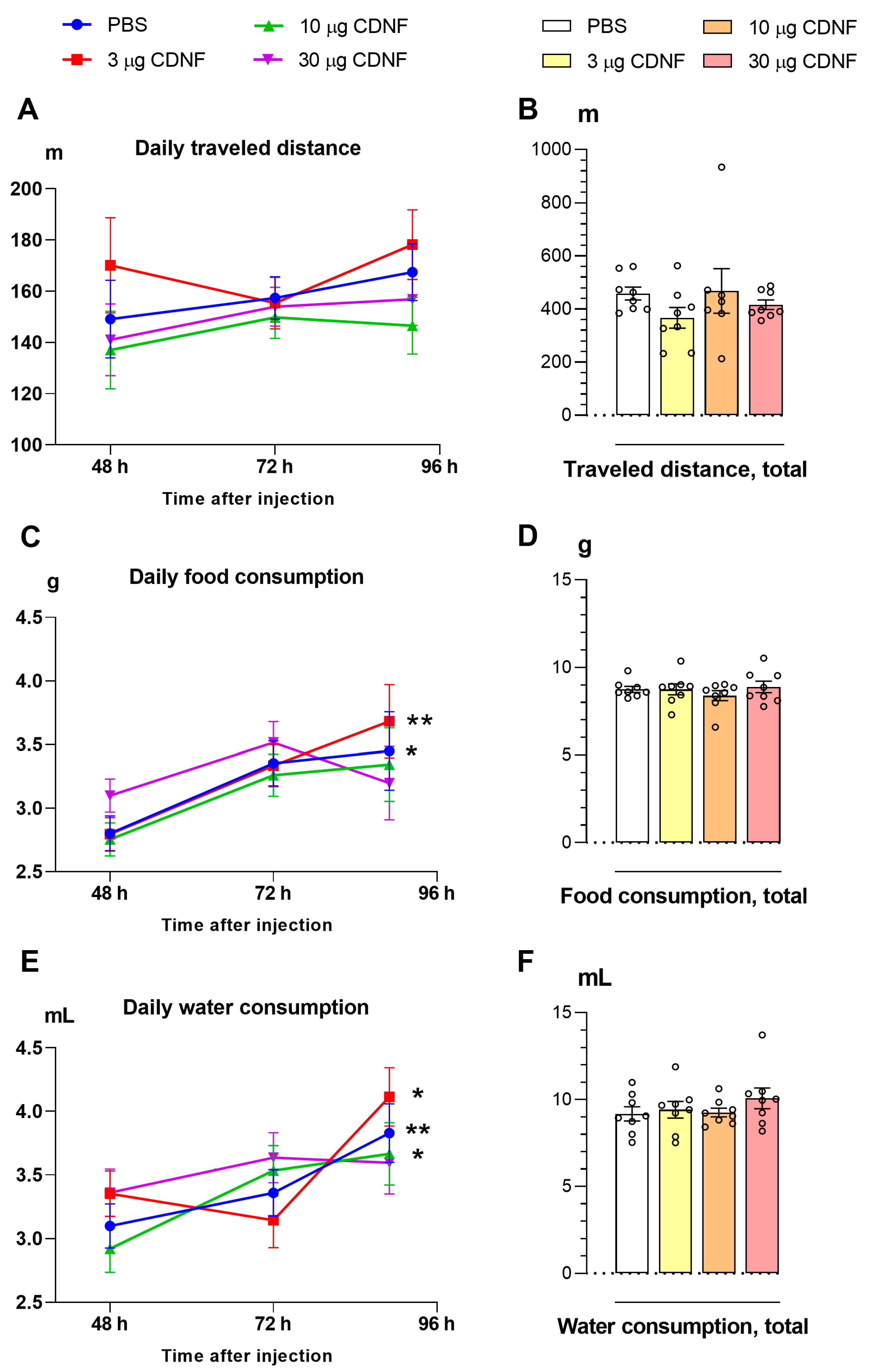
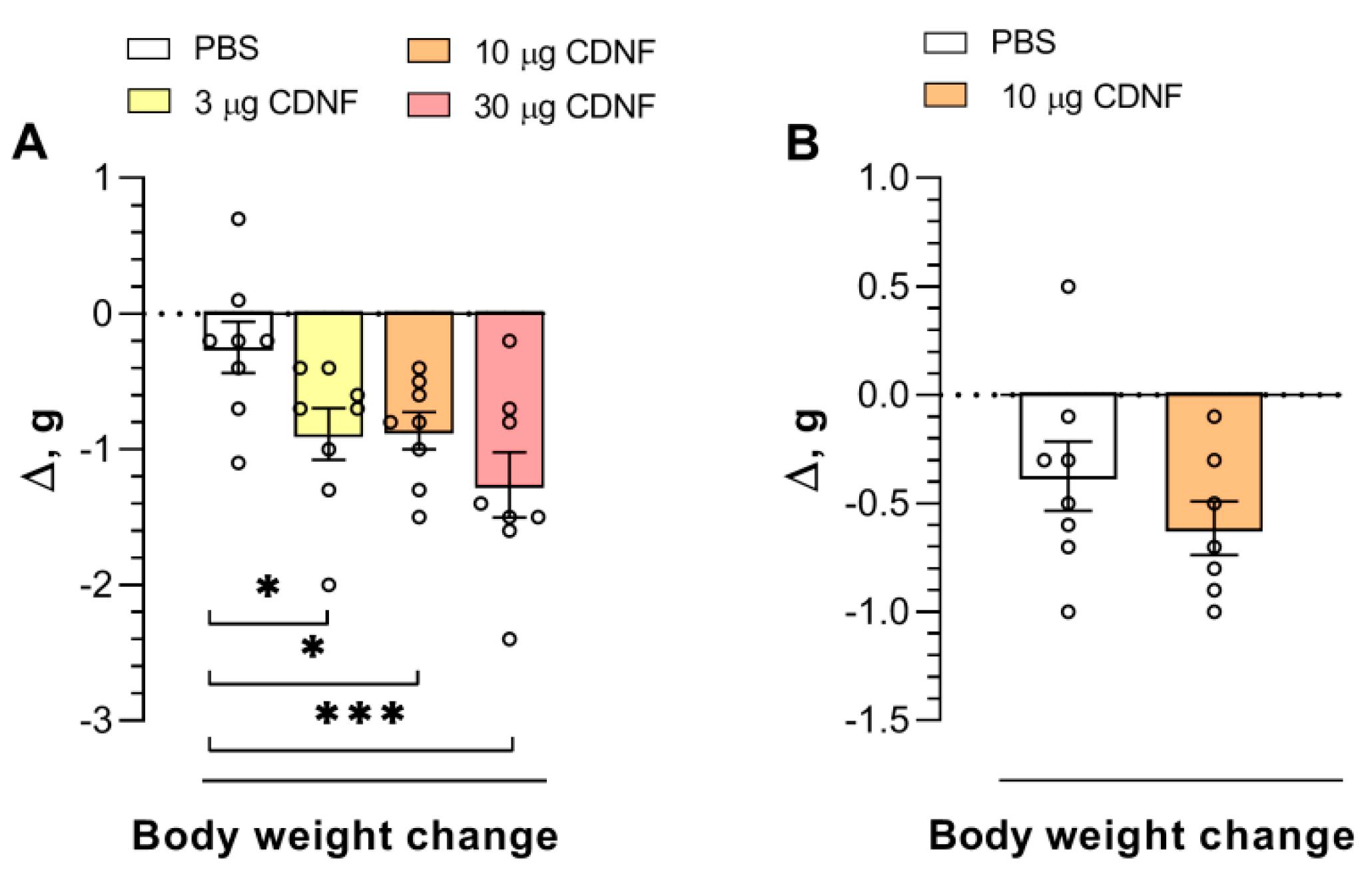
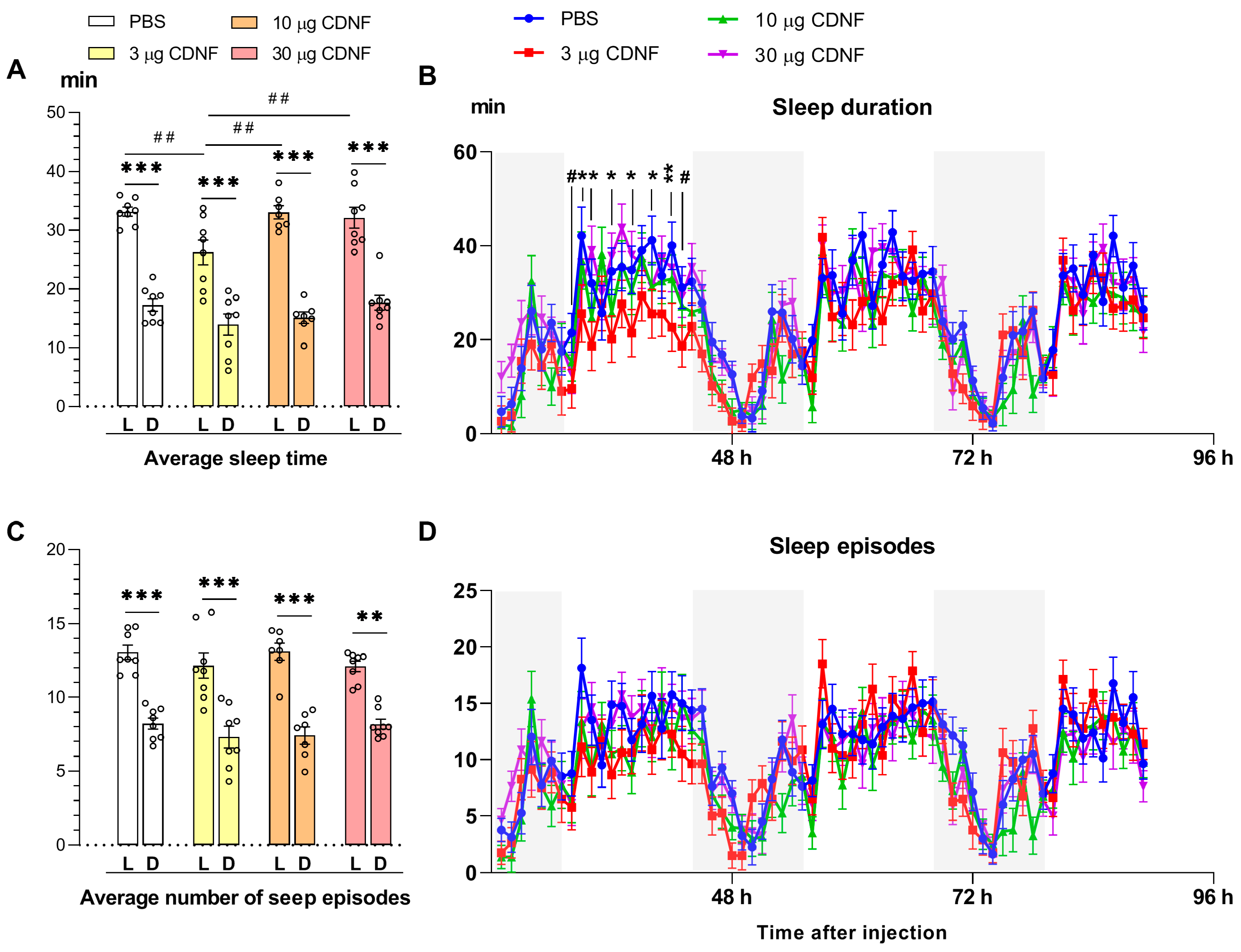
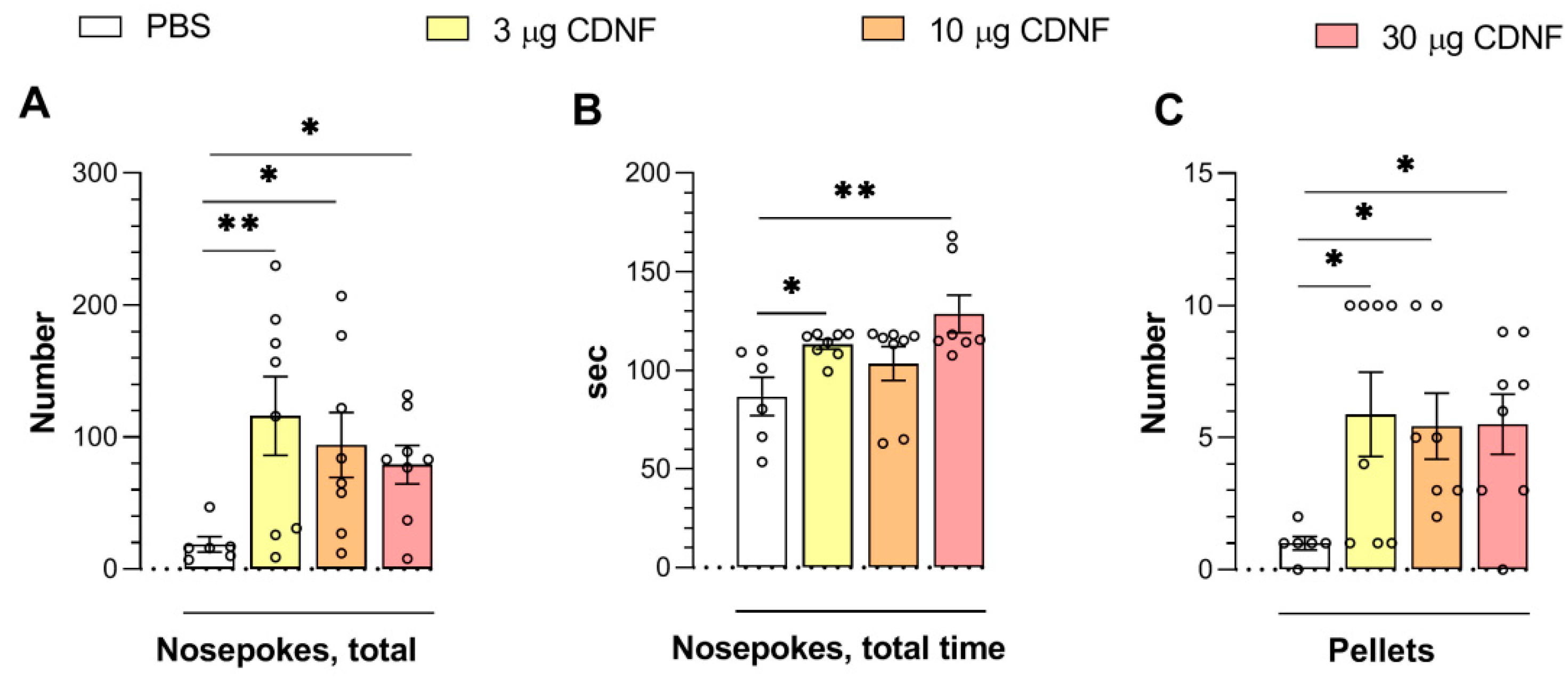
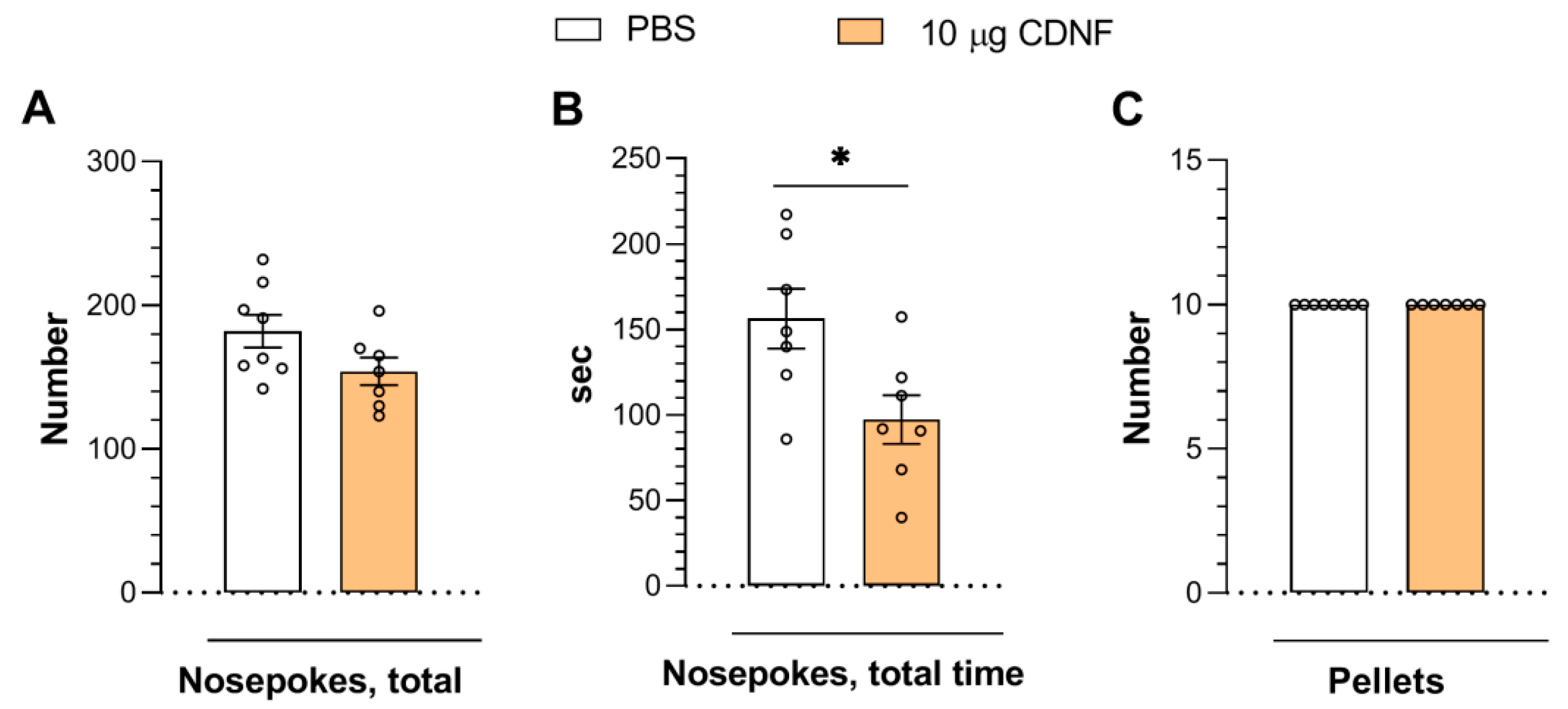
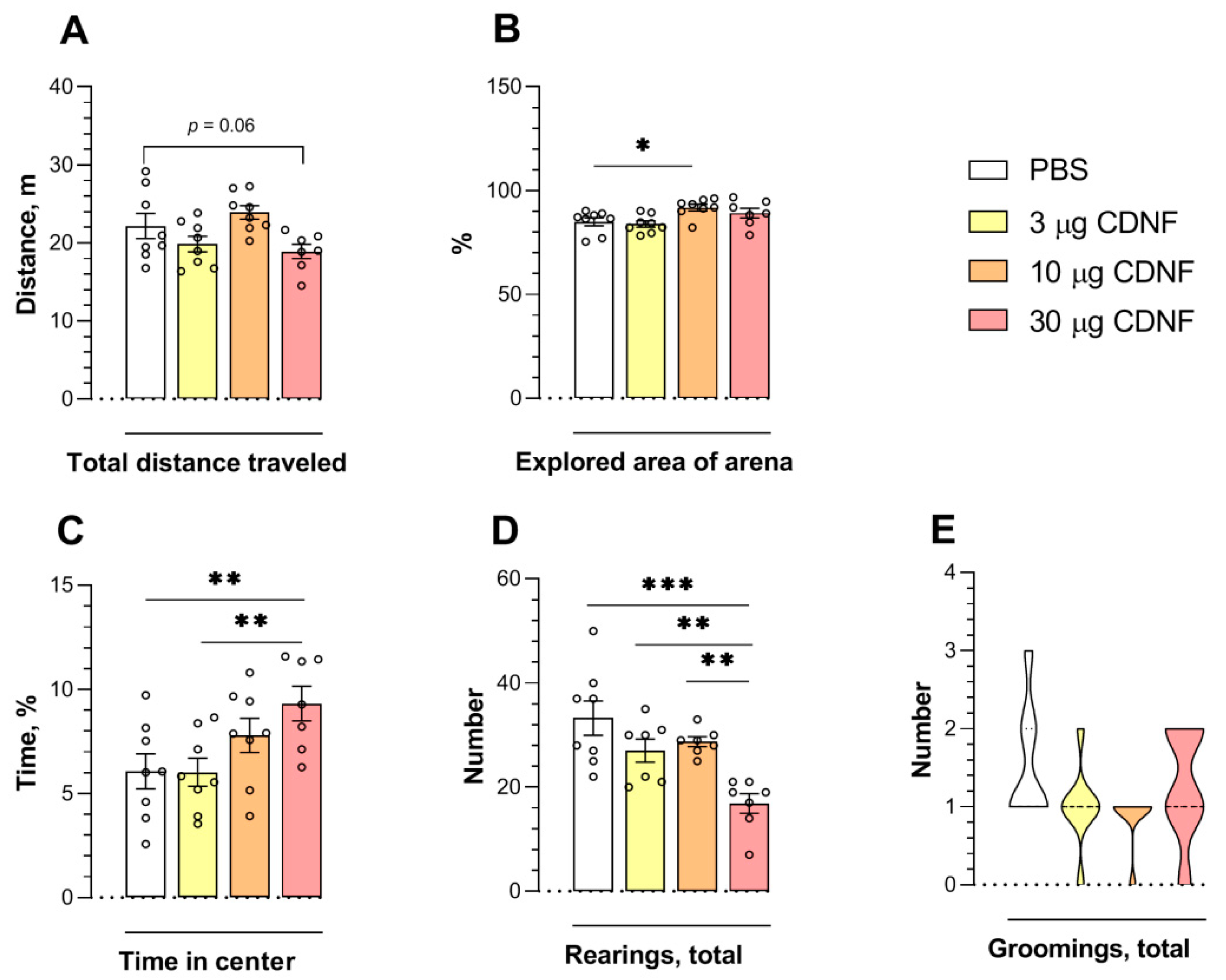

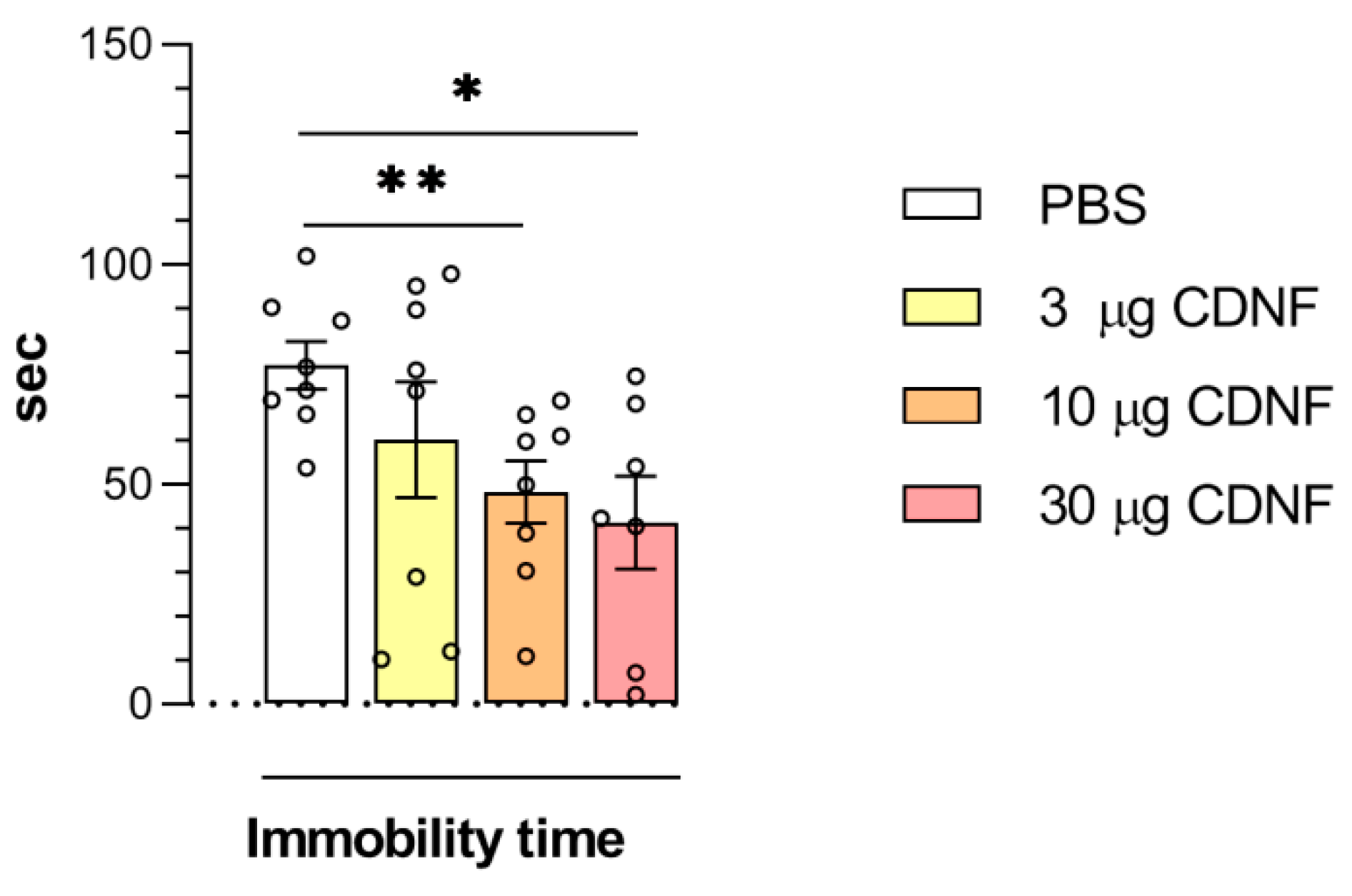
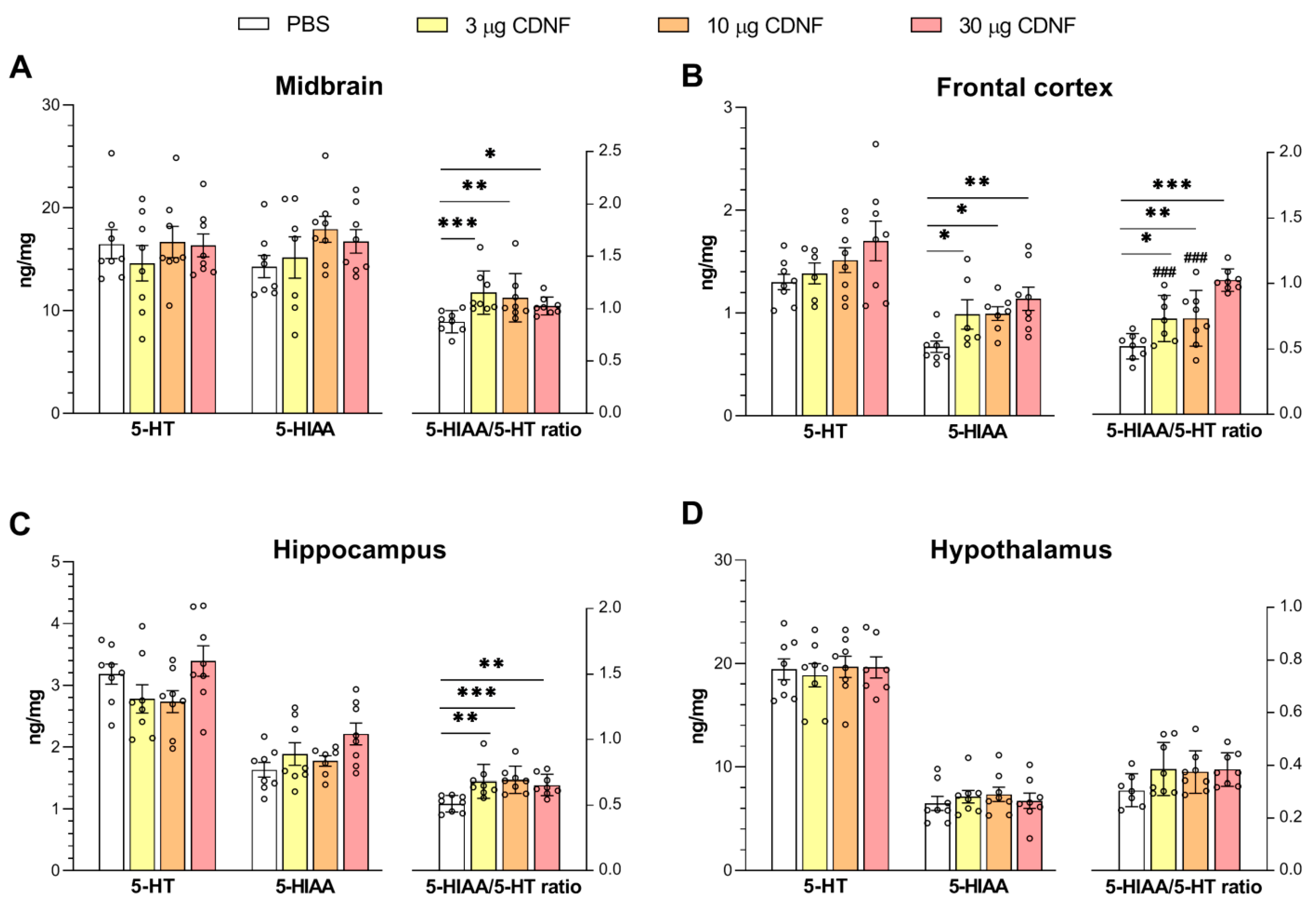

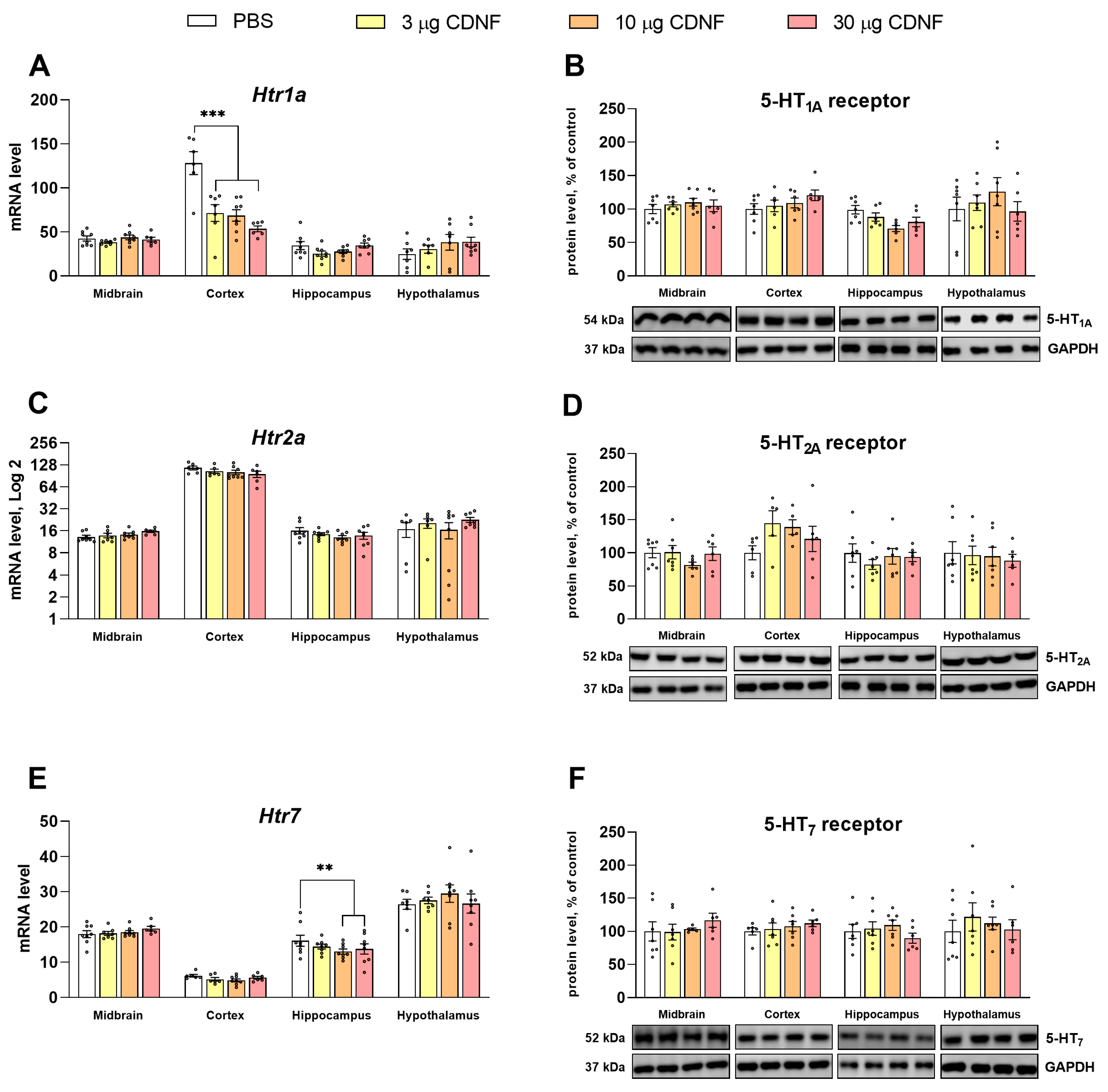
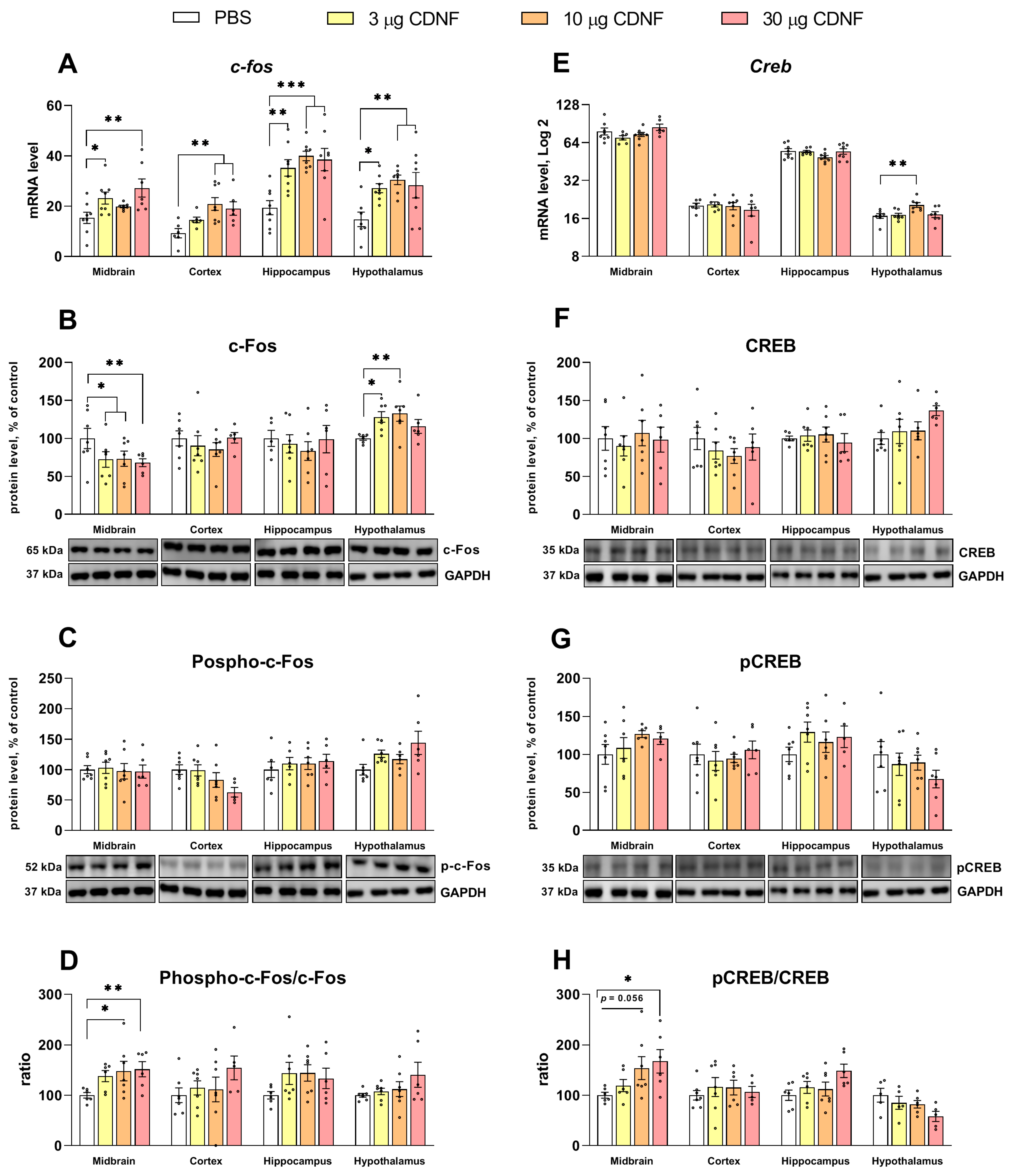

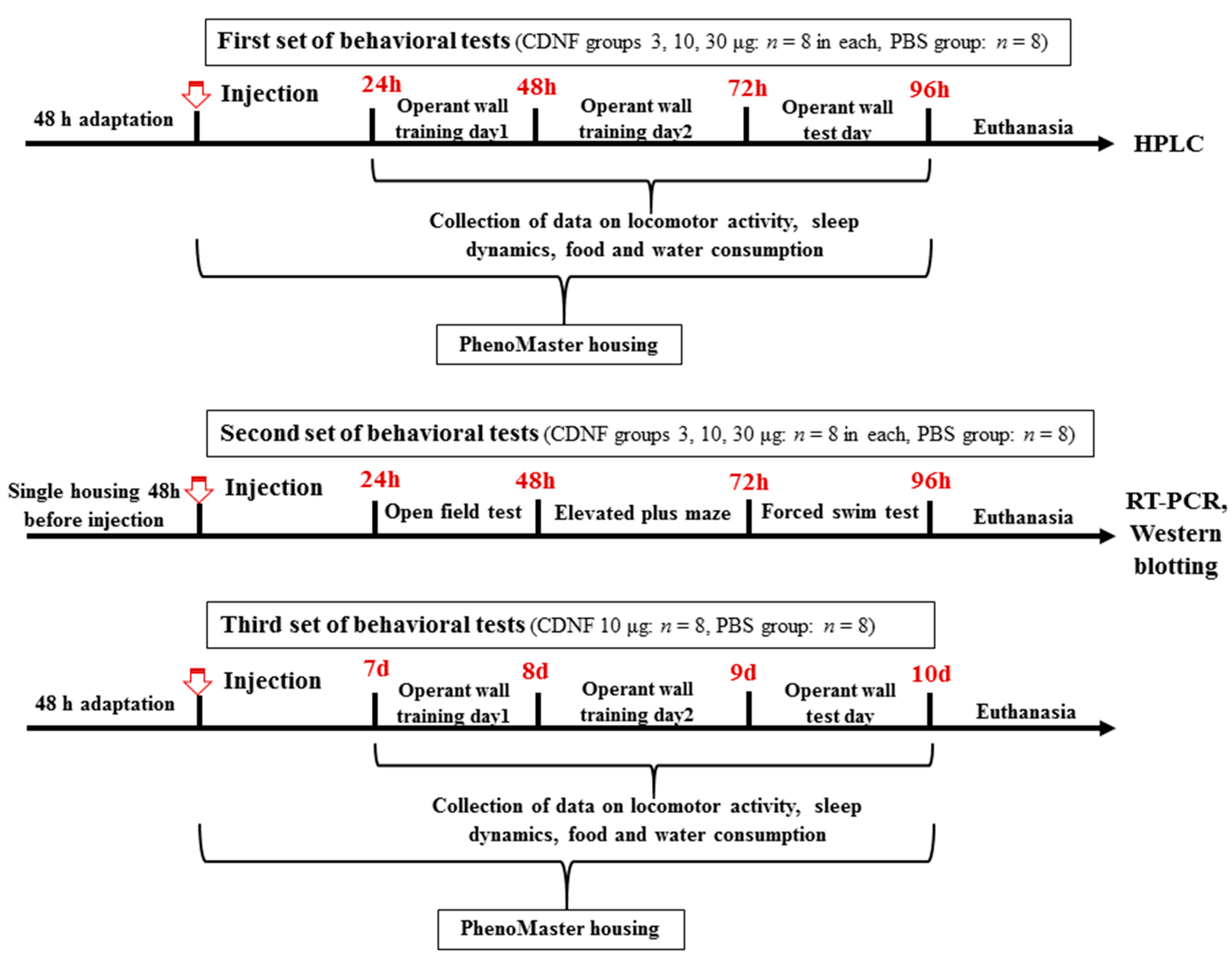
| Target Gene | Primer Sequences | Annealing Temperature, °C | Amplicon Length, bp |
|---|---|---|---|
| Polr2 | F 5′-GTTGTCGGGCAGCAGAATGTAG-3′ R 5′-TCAATGAGACCTTCTCGTCCTCC-3′ | 61 | 188 |
| Htr1a | F 5′-CTGTGACCTGTTTATCGCCCTG-3′ R 5′-GTAGTCTATAGGGTCGGTGATTGC-3′ | 62 | 109 |
| Htr2a | F 5′-AGAAGCCACCTTGTGTGTGA-3′ R 5′-TTGCTCATTGCTGATGGACT-3′ | 61 | 169 |
| Htr7 | F 5′-GGCTACACGATCTACTCCACCG-3′ R 5′-CGCACACTCTTCCACCTCCTTC-3′ | 65 | 198 |
| Tph2 | F 5′-CATTCCTCGCACAATTCCAGTCG-3′ R 5′-CTTGACATATTCAACTAGACGCTC-3′ | 61 | 239 |
| Slc6a4 | F 5′-CGCTCTACTACCTCATCTCCTCC-3′ R 5′-GTCCTGGGCGAAGTAGTTGG-3′ | 63 | 101 |
| Maoa | F 5′-AATGAGGATGTTAAATGGGTAGATGTTGGT-3′ R 5′-CTTGACATATTCAACTAGACGCTC-3′ | 61 | 138 |
| c-Fos | F 5′-AAAGAGAAGGAAAAACTGGAG-3′ R 5′-CGGAAACAAGAAGTCATCAA-3′ | 58 | 264 |
| Creb | F 5′-GCTGGCTAACAATGGTACGGAT-3′ R 5′-TGGTTGCTGGGCACTAGAAT-3′ | 64 | 140 |
| Atf6 | F 5′-CTCAAACCAATGCCAGTGTCC-3′ R 5′-ATGCTGATAATCGACTGCTGC-3′ | 59 | 94 |
| Grp78 | F 5′-CGCTCTACCATGAAGCCTGT-3′ R 5′-AGCCTCATCGGGGTTTATGC-3′ | 60 | 174 |
| Ire1α | F 5′-TCTGGGGATGTCCTGTGGAT-3′ R 5′-CTTGGCCTCTGTCTCCTTGG-3′ | 60 | 195 |
| uXbp1 | F 5′-CAGACTACGTGCACCTCTGC-3′ R 5′-CAGGGTCCAACTTGTCCAGAAT-3′ | 60 | 139 |
| sXbp1 (cDNA) | F 5′-GCTGAGTCCGCAGCAGGT-3′ R 5′-CAGGGTCCAACTTGTCCAGAAT-3′ | 60 | 130 |
| Target Protein | Primary Antibody | Secondary Antibody: Dilution, Manufacturer Code | |
|---|---|---|---|
| Antibody Dilution | Manufacturer Code | ||
| 5-HT1A | 1:1000 | Ab 85615 (Abcam, Cambridge, UK) | Anti-rabbit 1:10 000, G-21234 (Invitrogen, Waltham, MA, USA) |
| 5-HT2A | 1:500 | Ab 66049 (Abcam, UK) | |
| 5-HT7 | 1:1000 | Ab 128892 (Abcam, UK) | |
| TPH-2 | 1:1000 | Ab 184505 (Abcam, UK) | |
| 5-HTT | 1:1000 | 303614 (USBiological Life Sciences, Salem, MA USA) | |
| MAOA | 1:1000 | Ab 126751 (Abcam, UK) | |
| CREB p-CREB | 1:1000 1:1000 | Ab3138 (Abcam, UK) Ab 32096 (Abcam, UK) | |
| c-Fos p-c-Fos | 1:500 1:1000 | Sc-52 (Santa Cruz Biotechnology, Santa Cruz, CA, USA) D82c12 (Cell Signaling Technology, Danvers, MA, USA) | Anti-rabbit 1:8000, G21234 (Invitrogen, USA) |
| GAPDH | 1:7000 | Ab 8245 (Abcam, UK) | Anti-mouse 1:30 000, ab6728 (Abcam, UK) |
Disclaimer/Publisher’s Note: The statements, opinions and data contained in all publications are solely those of the individual author(s) and contributor(s) and not of MDPI and/or the editor(s). MDPI and/or the editor(s) disclaim responsibility for any injury to people or property resulting from any ideas, methods, instructions or products referred to in the content. |
© 2024 by the authors. Licensee MDPI, Basel, Switzerland. This article is an open access article distributed under the terms and conditions of the Creative Commons Attribution (CC BY) license (https://creativecommons.org/licenses/by/4.0/).
Share and Cite
Tsybko, A.; Eremin, D.; Ilchibaeva, T.; Khotskin, N.; Naumenko, V. CDNF Exerts Anxiolytic, Antidepressant-like, and Procognitive Effects and Modulates Serotonin Turnover and Neuroplasticity-Related Genes. Int. J. Mol. Sci. 2024, 25, 10343. https://doi.org/10.3390/ijms251910343
Tsybko A, Eremin D, Ilchibaeva T, Khotskin N, Naumenko V. CDNF Exerts Anxiolytic, Antidepressant-like, and Procognitive Effects and Modulates Serotonin Turnover and Neuroplasticity-Related Genes. International Journal of Molecular Sciences. 2024; 25(19):10343. https://doi.org/10.3390/ijms251910343
Chicago/Turabian StyleTsybko, Anton, Dmitry Eremin, Tatiana Ilchibaeva, Nikita Khotskin, and Vladimir Naumenko. 2024. "CDNF Exerts Anxiolytic, Antidepressant-like, and Procognitive Effects and Modulates Serotonin Turnover and Neuroplasticity-Related Genes" International Journal of Molecular Sciences 25, no. 19: 10343. https://doi.org/10.3390/ijms251910343






